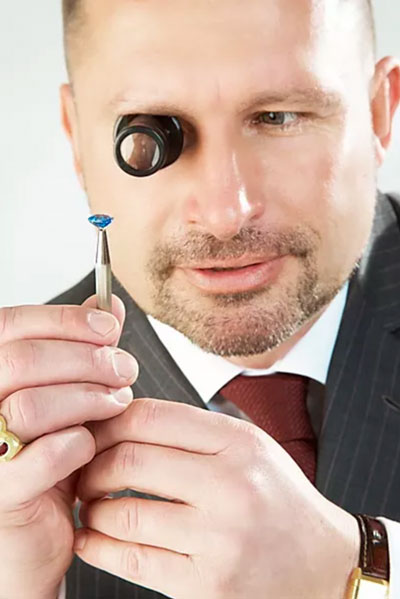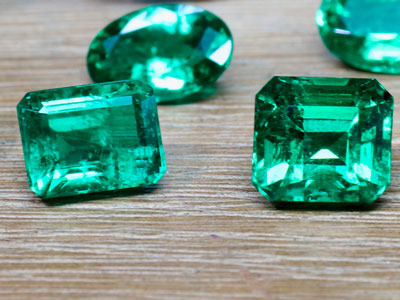Knowledge
09.03.2021 Gemstone Treatments: How stones are “enhanced”
Already around the birth of Christ, it was noticed that the quantity of “beautiful” gemstones was not enough to satisfy the worldwide demand at the time. Therefore, people began to treat gems in order to enhance the quality: Rubies and sapphires were heated to optimize color and purity and emeralds were soaked in (cedar) oil to conceal cracks.

Since then, attempts to artificially increase the value of gemstones have become increasingly outlandish and sophisticated. On the other hand, laboratory tests evolved, and it is possible to detect all treatments (that always reduce the value). For this very reason, when buying a gemstone, a certificate from an internationally recognized gemstone laboratory is a must.
A distinction must be made in all gemstones between treatments that are permanent and can hardly be reversed (examples are heating in the case of sapphires or crack filling with lead glass in the case of rubies) and those that are temporary and can also be reversed (e.g. “oiling” in the case of emeralds).
Cutting gemstones is not considered a treatment. Natural, untreated gemstones are only those whose color or purity has not been artificially altered.
Furthermore, there are synthetic gemstones, which are artificial products made by man in a laboratory and have identical chemical and physical properties as the natural minerals. In addition, there are “artificial stones”, which are created by humans, but do not occur in nature. An example of this is zirconia or YAG. Another distinction concerns imitations, which have nothing in common with the natural product, but only look something like it (e.g. red glass instead of ruby).
Cutting gemstones is not considered a treatment

CIBJO Rules for Handling Treated Gemstones

To establish rules in the trade regarding treatments of gemstones, first in 1926 the BIBOAH was founded and in 1961 it was transformed into the “Confederation Internationale de la Bijouterie, Joallerie, Ofevrie, des Diamantes, Perles et Pierres (CIBJO)” based in Switzerland. This organization establishes rules for the trade of jewelry, diamonds, colored gemstones, and pearls. These “CIBJO rules” do not have the force of law, they are to be understood as a trade custom.
According to CIBJO, some treatments of gemstones require a “General Information” to be given when:
- existing cracks in a gemstone has been filled with colorless substances,
- a gemstone has been waxed on the surface,
- a gemstobe has been heated or
- has been bleached.
In addition, there are treatments that must be given to the buyer as “Special Information”, among which are:
- Lead glass treatment on ruby
- Diffusion treatment
- Treatment with coloring agents or coloring substances
- Fracture or cavity filling
- Impregnation with synthetic material
- Coatings for stones
Even this “special information” is often not given. An example: Almost 100% of all “blue topaz” on the market, whose color is intense, are irradiated.
According to the treatments, CIBJO has introduced a three-letter system for marking gemstones:
- „N“ – Natural: Gemstones that have been processed only by cutting and polishing.
- „E“ – Enhanced: Gemstones that have been modified by commercially accepted methods and thus require “General Information.
- „T“ – Treated: Gemstones that have been treated by methods that require “Special Information”.

The value of treated and untreated gems
Descending from the highest value down to the lowest monetary value for gemstones, the following order applies for natural to treated stones:
- Untreated stones
- Heated stones
- Diffusion treated stones
- Crack filled stones
In summary: All these treatments must be disclosed to the buyer; if a dealer fails to do so, he is liable. The more treatment a stone has undergone, the lower its resale value.


Common Treatment Methods
For the “Big Four,” Ruby, Sapphire, Emerald and Diamond, the following treatment methods are often used to hide a stone’s weaknesses.
Treatments of Ruby and Sapphire
Since ruby is the second most expensive gemstone in small sizes (compared to diamond) and the most expensive gemstone in sizes from 4 to 10 ct, it is also the number one target for treatments and fakes.
The most common treatment method used for corundum, i.e. ruby and sapphire, is heat treatment. Almost all corundum available in the jewelry trade today has been treated this way.
Two types are distinguished here: In the low-temperature treatment, inclusions of minerals that are not corundum are retained. In the case of ruby, this is primarily rutile, whose crystals are not melted. Low-temperature is present up to about 1,100 degrees Celsius since rutile begins to melt at about 1,200 – 1,350 degrees. If the rutile has melted, then this is referred to as “high temperature treatment”.
The temperature, the duration of the temperature, the atmosphere during heating, and the chemical structure of surrounding or co-fired materials all have an influence on the result during heat treatment.
Heat treatment between 1,100 and 1,800 degrees Celsius can remove undesirable brown, purple or purplish hues from ruby. Prolonged firing of rubies between 1,450 and 1,750 degrees Celsius, followed by rapid cooling, can also remove unwanted “rutile silk.” After a heat treatment, the treated ruby is purer to our eyes than before.
Light blue or milky sapphires become intensely blue by heating them at 1,250 to 1,700 degrees Celsius. Conversely, stones that are too dark can also be optically lightened using oxygen and thus made more attractive. Almost colorless to pale yellow sapphires become intensely yellow by heating at 1,000 to 1,800 degrees Celsius. Here, divalent iron is oxidized into trivalent iron. Treated sapphires that were pink when untreated can change to orange sapphires – toward the famous and prized “Padparadschas.”
Since the 1990s, rubies have been thermally treated along with chemical additives. In this process, color and transparency are improved. Often used is a melt of borax, quartz, and other chemical additives in which the ruby is heated for 10 to 20 hours. The borax melt also enters cracks and breakouts; in this way the transparency is improved. The residues of this melt can be detected in the laboratory. Since 2004, rubies treated with lead glass have also been sold, which also improves transparency.
A strong intervention is the “diffusion treatment”. Here, stones are colored by coloring substances, with a penetration depth of only 0.01 to 0.5 mm. Therefore, the stones are colored only at the edges. Due to the high temperatures used in this method, the stones must be re-polished, again removing material that has been colored. Therefore, these stones can be recognized due to their different color intensity. The stone is placed in a muddy slurry of titanium, beryllium, or chromium oxides under temperatures of 1,600 – 1,900 degrees Celsius.
When rubies are cracked, colors penetrating the cracks are sometimes used, sometimes in the form of oil. One speaks then as with the emerald of “oiled stones”.
By radioactive irradiation, pale yellow sapphires can be transformed into dark yellow, although the color is not stable but loses its intensity over time.


Treatments of emerald
Heating as with corundum does nothing for emerald. The gemstone does not react to temperature and may even be destroyed by it. Only with the other colors of beryl, with aquamarine and with salmon-colored stones, heating is used. However, the temperature here is usually only 250 to 500 degrees Celsius, which means that this treatment cannot be proven in retrospect to this day.
Emeralds are generally brittle and show natural cracks. It was therefore already recognized in ancient times that by using colorless oils, these cracks can be made almost invisible to the eye. Cedarwood oil, which is very often used for this purpose, has a light refraction that is very close to that of emerald and therefore makes the cracks “disappear” to the human eye.
Today, instead of cedar oil, soft resins (for example, Canada balsam) or mostly synthetic resins are used because they give a more durable result than with natural oil and have an even more “suitable” light refraction than the oil. These fillings are often hardened by a hardening substance or by ultraviolet radiation.
Generalized, the following treatments exist in emerald:
- those that improve color (green colored oils or resins in pale emerald)
- those that improve purity (oils and resins)
- those that improve stability (especially resins for brittle stones)
All the above methods can be detected in a laboratory under a microscope. A new addition seems to be the method of enhancing the color intensity of emeralds from Colombia by irradiation.
Treatment of diamonds
If diamonds are bombarded with neutrons in an atomic reactor, these neutrons penetrate deep into the gemstone and color it green to blue green. Irradiation with protons, deuterons, or alpha particles also produce a green color, but the penetration depth is not great. Treatment with accelerated electrons produces blue to greenish-blue colors.
There are also “black” diamonds that come from this process; these can be identified by a green coloration at the edges. In truth, they are not black, but they are so deep green that they appear black to our eye. Most of all black diamonds on the market came to their color this way.
If the diamonds are also heated after irradiation (to around 700 degrees Celsius), they take on a yellow, brown, or orange color.
At the end of the 20th century, another method was invented: the high-pressure, high-temperature (HPHT) process. This was first used to produce synthetic diamonds. However, it has also been used since 1996 to treat brown diamonds towards green, yellow-green, or yellowish-green stones. This transformation of color happens during a period of about three minutes at a pressure of 55 to 60 kilobars and temperatures between 1,900 and 2,200 degrees Celsius.
If diamonds are first HPHT-treated, then irradiated and heated, pink to reddish colors can also be produced.
Treatment by laser drilling is also relatively new. Here, a diamond with strong inclusions around the inclusions is drilled with a laser and then treated with acid (mostly hydrofluoric acid). The acid penetrates the drill channel and decomposes the inclusion. The resulting drill channels are filled with synthetic resin or glass.
Finally, crack fillings are used to make cracks in the diamond invisible to the human eye. Since 1987, this method has used highly refractive glass or synthetic resins to fill cracks.
White diamonds are to a very large extent still untreated, but colored diamonds treated more often than not.

